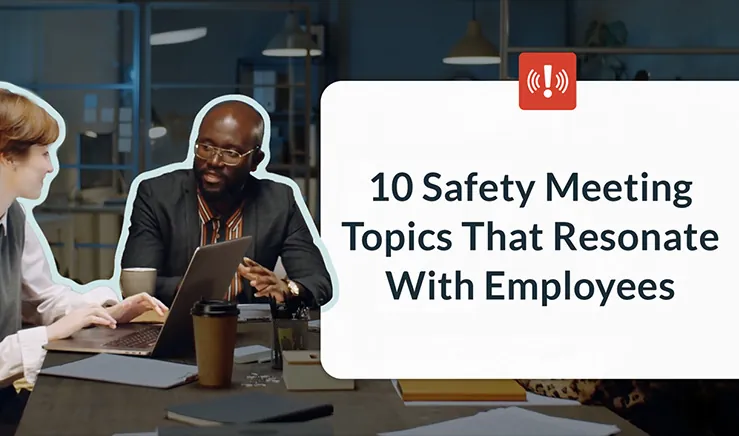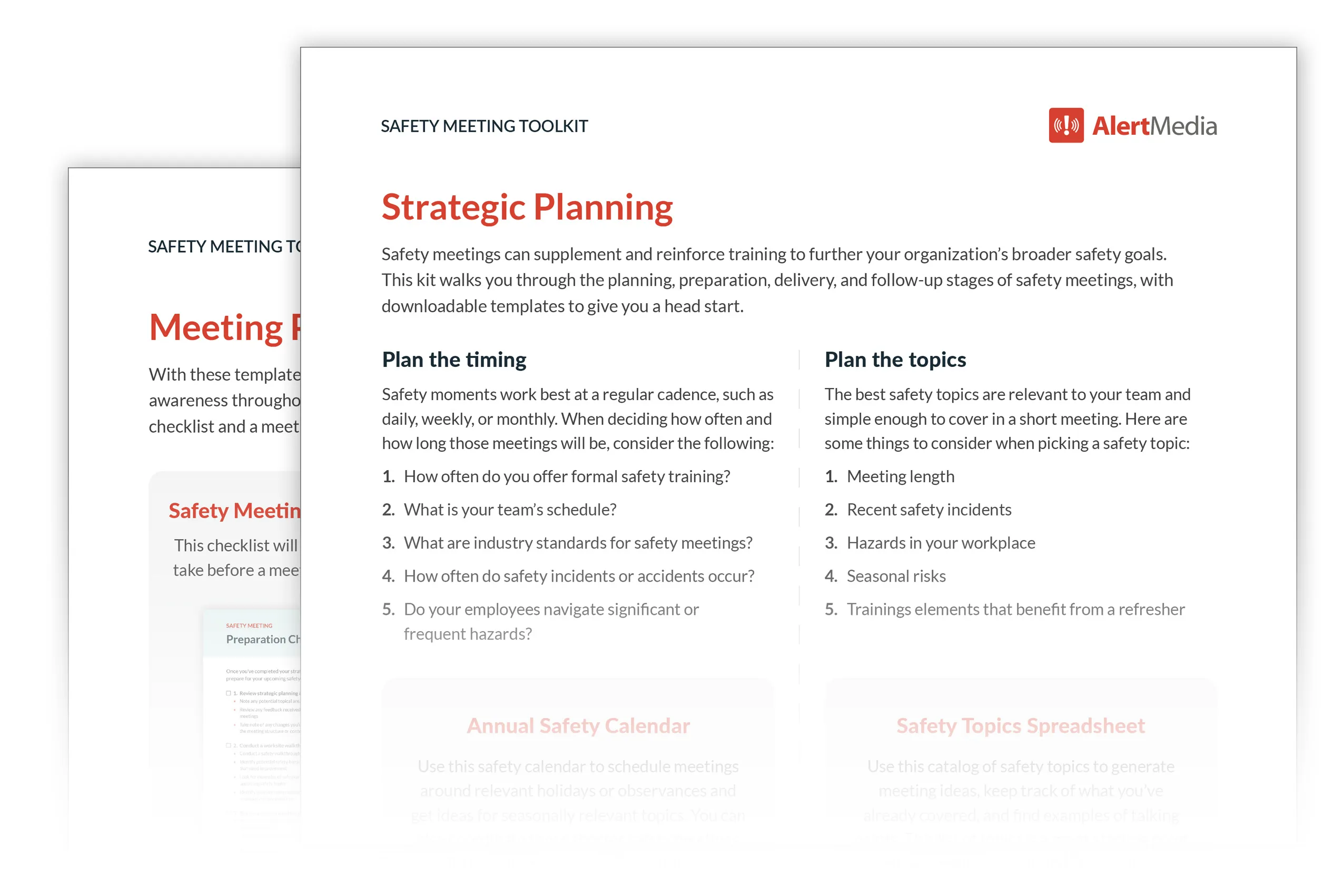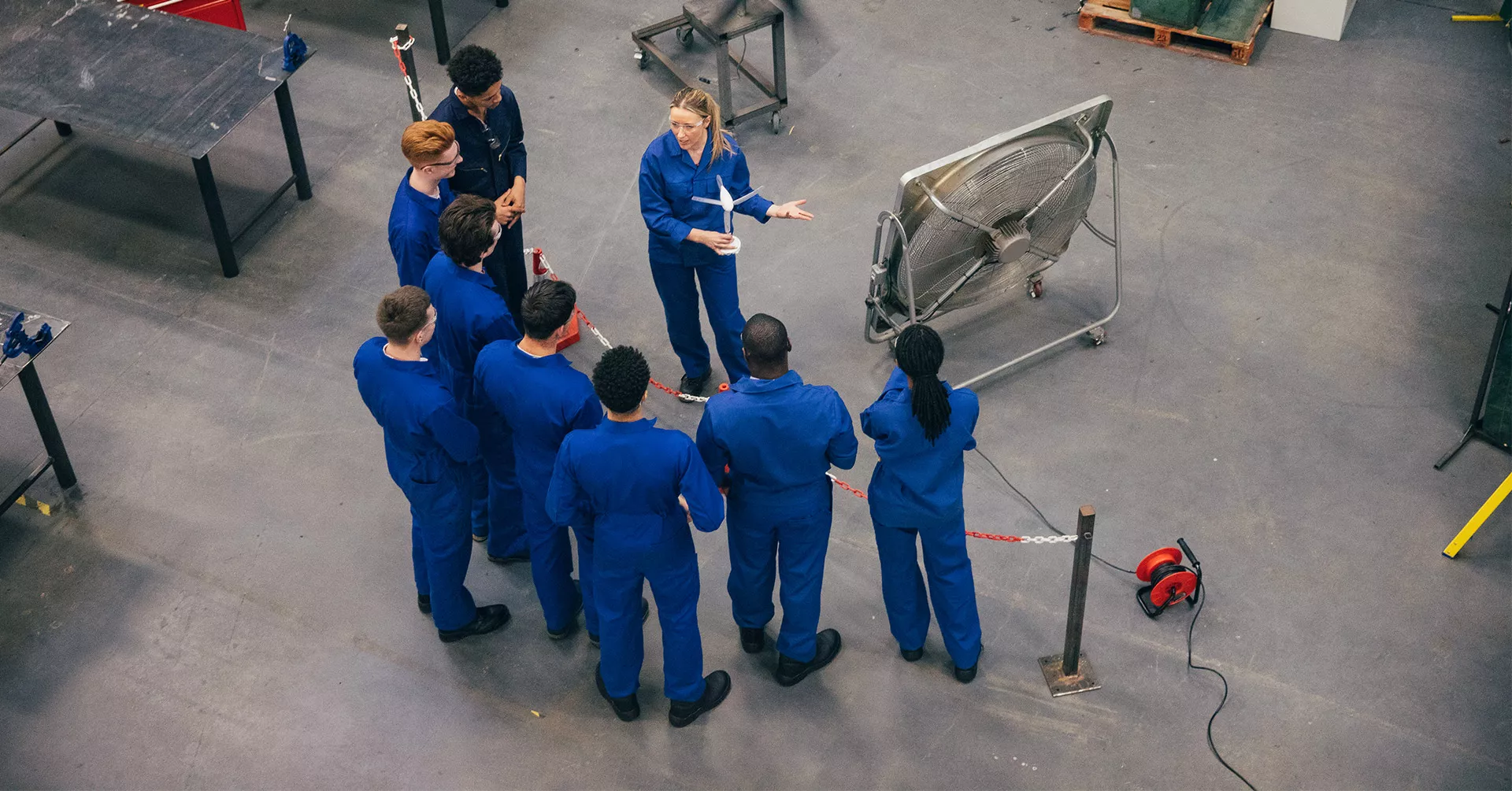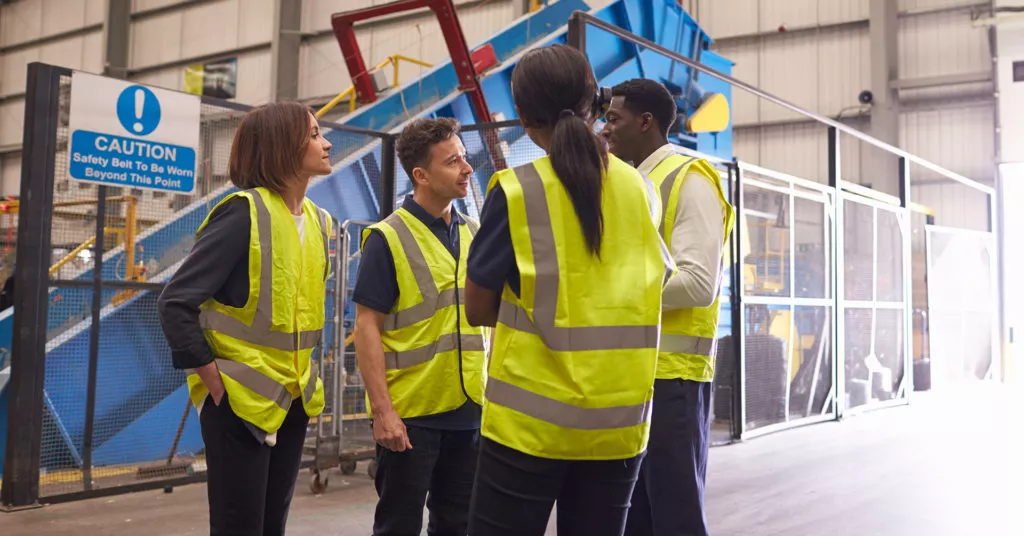
Safety Moment Ideas: 25 Topics to Enhance Safety Culture
To supplement safety training and keep employees engaged, plan safety moments on a range of topics. Here are 25 ideas to get you started building a strong culture of safety.
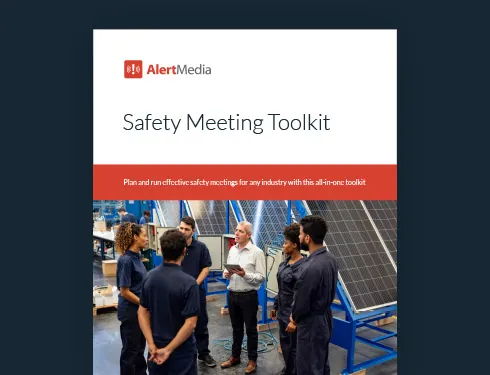
“People have a sense of ownership when they're involved... Training is just the tip of the iceberg.”Adam Corn Director of Safety & Security and Training & Development, GoFundMe
Keeping employees engaged in safety training topics is a significant challenge even for seasoned safety leaders. Most audiences begin to lose interest within the first 10 minutes of a presentation, making it difficult to convey critical information effectively.
This is where safety moments come in. These brief, focused discussions are designed to deliver key safety messages in a concise and impactful way. By integrating safety messages into daily routines, you can reinforce essential practices without overwhelming your team. Think of them as bite-sized reminders that keep safety top of mind and help prevent complacency.
In this article, we’ll explore what safety moments are, how to make the most of them, and provide a variety of safety moment ideas to help you keep safety at the forefront of your workplace culture.
Safety Meeting Toolkit
What Is a Safety Moment?
A safety moment is a brief talk about a specific, safety-oriented topic at the beginning of a meeting. Safety moments for work are usually between five and 10 minutes long and may also be called “safety minutes,” “safety chats,” or “safety shares.”
Teams can approach these conversations in different ways to maximize the impact. But there are a few common aspects of most companies’ safety moments:
- Keep them short, usually lasting approximately five minutes and never more than 10
- Focus on a single topic rather than jumping around or overloading participants with information
- Orient the safety message toward your team’s upcoming day or week, not long-term planning
- Use safety moments to support a positive safety culture through clear, concise, and engaging communication
Safety moments vs. toolbox talks
You might have heard the term “toolbox talks” and wonder how they compare to safety moments. The tradition of toolbox talks may have begun on construction sites or similar job sites where there is a need to regularly brush up on equipment safety procedures. This term is used in diverse workplaces today, just as safety moments are used to establish regular informal discussions of actionable safety information.
In any case, the meaning of each of these terms is rooted in how teams use them—rather than strict definitions—and there is bound to be a wide variety of approaches to supporting safety outcomes for unique industries, organizations, and leadership teams.
Along with “safety moments” and “toolbox talks,” other common names include “safety minutes,” “safety talks,” and “tailgate meetings.” To choose an effective name, consider the tone and goals you’re aiming for—and the setting for your talks. What resonates for a roofing company may not resonate for an accounting firm.
Watch this video to learn the fundamentals of compelling safety moments, discover new safety training ideas, and get facilitation tips.
Why are safety moments important?
Safety moments are a valuable tool to deliver or reinforce critical information, such as safety protocols and standards, occupational safety concerns, and any other workplace safety messages that will lead to better outcomes.
Topics can cover routine safety issues but are also a great way to highlight timely hazards. Say, for example, your team is operating heavy machinery they haven’t worked with in a few months. At the start of the day, a quick safety moment covering the risks and precautions can help ensure everyone is aware and prepared.
Safety shares are also a great way to encourage safety engagement. Routine safety training can sometimes feel abstract and easy to tune out. However, since safety moments cover topics that are immediately relevant, employees are more likely to give their full attention and participation to the daily safety messages.
How and When to Integrate Safety Messages
The ideal frequency and format for safety moments vary by setting and industry. Companies with workers based mostly in offices will usually hold safety moments in conference or break rooms. And given the less hazardous environment, weekly safety moments may be sufficient. They can also be a great complement to your monthly safety topics.
Conversely, higher-risk workplaces like warehouses or construction sites might hold daily moments to reinforce salient points and help prepare workers for what they’re doing that day.
Pro tip: A well-structured safety meeting agenda can help you organize your sessions and keep them engaging and productive.
25 Safety Moment Ideas for 2025 and Beyond
To determine the most productive safety meeting topics for your workplace, first, perform a business threat assessment. No two organizations—or even worksites within an organization—face the same risks. Offices, kitchens, factories, and construction sites all have unique conditions that can impact your employees’ workplace safety. When you have a clear understanding of the hazards that might impact your people, you can plan for training sessions, including safety messages to address smaller safety topics or refreshers of more in-depth safety training topics.
Here are 25 safety moment ideas to improve general safety and inspire detailed presentations about the hazards in their work environments.
Universal safety moment topics
1. Situational and safety awareness
One of the most important skills you can help your employees develop is situational awareness in the workplace because it can help prevent workplace accidents and ensure employee safety. Encourage employees to stay focused on their tasks and remain aware of their surroundings at all times. Discuss actionable strategies, such as minimizing distractions, reviewing safety checklists before starting hazardous tasks, and recognizing warning signs of potential dangers. Additionally, emphasize the importance of reporting unsafe conditions or behaviors.
Situational awareness also extends to mental health and well-being. Encourage employees to be mindful of stress and fatigue, which can impair judgment and increase risks. Remind those who travel or drive for work of the importance of staying alert and avoiding distractions like mobile devices. Situational awareness training is equally critical for distracted driving risks, social engineering attacks, and workplace violence threats.
2. Emergency exits and routes
Clearly marked emergency exits are essential for workplace safety. Use safety moments to remind employees of the location of the nearest exits and how to navigate evacuation routes safely.
Highlight the importance of keeping exits unobstructed and familiarizing themselves with posted evacuation maps. Discuss the role of assembly points and the importance of accounting for all team members during an emergency. Regular reminders can help ensure employees are prepared to act quickly and calmly in case of a fire, natural disaster, or other emergencies.
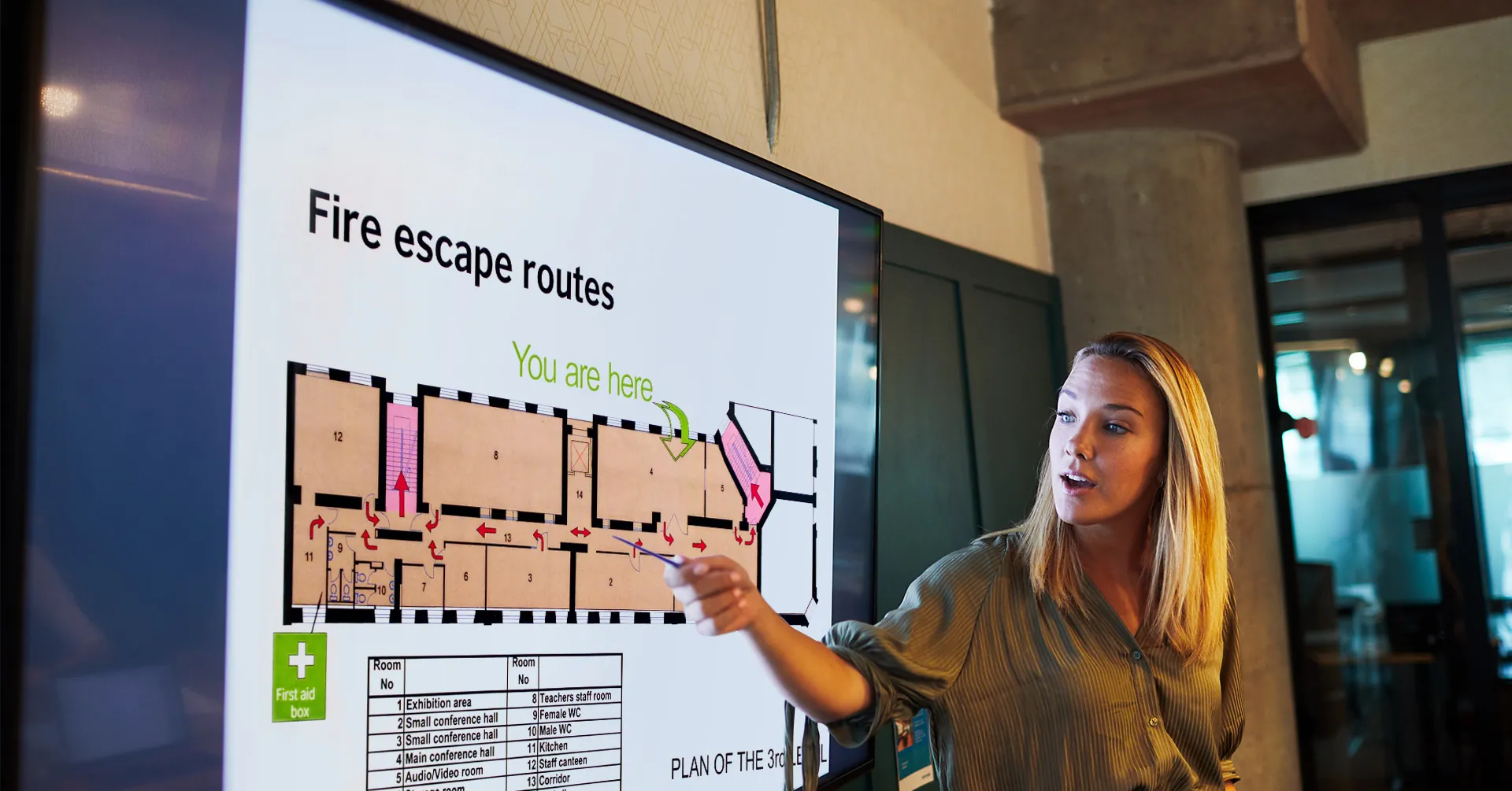
3. Security and access control
Unauthorized access to restricted areas can pose significant risks, whether accidental or intentional. Review your organization’s security policies, including badge access, visitor protocols, and procedures for reporting suspicious activity. Emphasize the importance of not allowing “tailgating” (unauthorized individuals following someone into a secure area) and the role employees play in maintaining a secure workplace. Encourage a culture of vigilance where employees feel empowered to report breaches or concerns.
4. Fire prevention and preparedness
Fire safety is a multifaceted topic that can be broken down into several safety moments. Discuss common fire hazards, such as overloaded electrical outlets, flammable materials, and improper storage to support workplace fire prevention efforts. Review the location and proper use of fire extinguishers, as well as the PASS technique (Pull, Aim, Squeeze, Sweep). Outline employees’ roles during a fire, including evacuation procedures, designated meeting points, and the importance of not re-entering the building until it’s declared safe. Regular fire drills and safety reminders can help ensure everyone knows how to respond in an emergency.
5. The importance of proper rest
Fatigue is a significant contributor to workplace accidents and errors. Discuss how inadequate rest can impair cognitive function, reaction times, and decision-making. Encourage employees to prioritize sleep and take advantage of workday breaks to rest and recharge. Review your organization’s policies on break schedules and overtime to ensure employees aren’t overworking themselves. Highlight the connection between physical well-being and workplace health and safety, and remind employees that taking care of themselves is a key part of staying safe on the job.
6. Parking lot safety
Parking lots can be deceptively hazardous, with risks ranging from distracted driving to poorly lit areas. Use safety moments to review specific risks in your workplace parking areas, such as blind spots for large vehicles or uneven surfaces. Encourage employees to stay alert, avoid using their phones while walking, and be mindful of their surroundings.
Discuss the importance of reporting suspicious activity and knowing how to contact security or emergency services if needed. For those working late, emphasize the value of using the buddy system or security escorts when leaving the building.
7. Two-way communication with safety leaders
Effective communication is the backbone of any safety program. Review how your organization’s mass notification system works, including how employees can expect to receive alerts and how to check in during emergencies. Discuss the importance of reporting hazards, near misses, and safety concerns promptly. Encourage employees to actively participate in safety meetings and provide feedback on safety protocols. A culture of open two-way communication ensures that everyone is informed and engaged in maintaining a safe workplace.
Industrial, warehouse, and construction safety moment topics
8. Personal protective equipment usage
PPE is essential for protecting workers from hazards, but its effectiveness depends on proper use. Use safety moments to review the types of PPE required for specific tasks, such as hard hats, safety glasses, hearing protection, gloves, and respirators. Discuss how to properly fit and maintain PPE, including regular inspections for damage or wear. Emphasize the importance of wearing PPE at all times, even for quick tasks, as accidents can happen in an instant. Reinforce the idea that PPE is the last line of defense and should always be used in conjunction with other safety measures.
9. Heat stress prevention
With OSHA introducing new heat regulations, it’s crucial to educate employees about the dangers of heat stress and heat-related illnesses. Discuss the early warning signs of heat exhaustion, such as dizziness, nausea, and excessive sweating, and the importance of staying hydrated. Review strategies for staying cool, such as taking frequent breaks in shaded or air-conditioned areas and wearing lightweight, breathable clothing. Encourage employees to look out for one another and report any signs of heat-related issues immediately.
10. Forklift safety
Forklifts are powerful tools but can be dangerous if not operated correctly. Use safety moments to review key operating procedures, such as speed limits, load capacity, and the importance of maintaining clear visibility. Discuss the dangers of unauthorized passengers and the need for proper training and certification. Highlight the importance of using horns and lights to alert pedestrians and designate safe walking paths with floor markings. Regular reminders can help prevent accidents caused by complacency or improper use.

11. Heavy machinery
Operating heavy machinery requires constant vigilance and adherence to safety protocols. Discuss the specific risks associated with each piece of equipment, such as pinch points, moving parts, and the potential for rollovers. Review the importance of pre-operation inspections, proper training, and following manufacturer guidelines. Emphasize the need to avoid distractions and never bypass safety features, even if it seems to save time. Regular safety briefings can help reinforce these practices and prevent accidents.
12. Hazardous materials and chemicals
Working with hazardous materials requires strict adherence to safety protocols. Review the specific risks associated with the chemicals in your workplace, including flammability, toxicity, and reactivity. Discuss proper storage, handling, and disposal procedures, as well as the importance of using appropriate PPE. Teach employees how to respond to spills or exposures, including the use of safety showers, eyewash stations, and spill kits. Regular training ensures everyone knows how to work safely with these materials.
13. Injury treatment and reporting
Despite prevention efforts, injuries can still occur. Use safety moments to review your organization’s procedures for treating and reporting injuries. Discuss the location of first aid kits and how to access medical assistance. Emphasize the importance of reporting all incidents, no matter how minor, to ensure proper documentation and prevent future occurrences. Review OSHA reporting requirements and the role of incident investigations in improving workplace safety.
Retail and hospitality safety moment topics
14. Avoiding slips, trips, and falls

Slips, trips, and falls are among the most common workplace injuries, causing workers to miss an average of 14 days of work. Discuss potential hazards in your work environment, such as wet floors, cluttered walkways, and uneven surfaces. Review the importance of proper signage, timely spill cleanup, fall protection, and the use of non-slip footwear. Encourage employees to immediately report hazards and near misses and participate in regular safety inspections. Highlight the role of good housekeeping in preventing accidents and maintaining a safe workplace.
15. Piling, stocking, and shelving hazards
Improperly stacked or stored items can create significant risks. Discuss safe practices for stacking and shelving inventory, including weight limits and stability. Review the dangers of overloading shelves or blocking emergency exits. Emphasize the importance of step stool and ladder safety and avoiding overreaching. Regular reminders can help prevent accidents caused by falling objects or collapsing stacks.
16. Safe lifting techniques
Improper lifting is a leading cause of back injuries. Use safety moments to review proper lifting techniques, such as bending at the knees, keeping the back straight, and avoiding twisting motions. Discuss the importance of asking for help with heavy or awkward loads and using mechanical aids when available. Encourage employees to take breaks and stretch regularly to prevent muscle strain.
17. Shoplifting and robbery protocols
Employees in retail and hospitality settings need to know how to handle theft or robbery situations safely. Review your organization’s protocols, including how to de-escalate conflicts, when to involve security or law enforcement, and how to prioritize personal safety over property. Discuss the importance of remaining calm, following instructions, and avoiding confrontation. Regular training ensures employees are prepared to respond effectively in high-stress situations.
18. Knife safety
Knives are essential tools in many workplaces but can cause serious injuries if mishandled. Discuss proper knife handling techniques, including holding, cutting, and storing knives safely. Review safety tips for keeping knives sharp, as dull blades require more force and increase the risk of accidents. Emphasize the need for focus and attention when using knives and the importance of reporting any injuries immediately to maintain a safe working environment.
19. Working with heat and flames
Kitchens and other environments with heat sources pose unique risks. Discuss the dangers of hot surfaces, open flames, and steam, and review safe practices for using stoves, ovens, and fryers. Emphasize the importance of wearing appropriate PPE, such as oven mitts and aprons, and keeping flammable materials away from heat sources. Regular safety reminders can help prevent burns and even fatalities.
Office environment safety moment topics
20. Cybersecurity
Cyberattacks are a growing threat to businesses of all sizes. Researchers estimate that cyberattacks happen an average of every 39 seconds. Use safety moments to review best practices for avoiding phishing scams, using strong passwords, and recognizing suspicious emails or links. Discuss the importance of updating software and reporting any potential security breaches immediately. Encourage employees to stay vigilant and prioritize cybersecurity in their daily routines.
21. Electrical safety
Even in office settings, electrical hazards can pose significant risks. Discuss the dangers of frayed cords, overloaded outlets, and malfunctioning equipment. Review the importance of unplugging devices when not in use and avoiding using extension cords as permanent solutions. Encourage employees to report any electrical issues immediately to prevent fires or injuries.
22. Proper ergonomics
Poor ergonomics can lead to repetitive stress injuries and long-term health issues. Discuss the importance of proper desk setup, including chair height, monitor placement, and keyboard positioning. Review the benefits of ergonomic accessories, such as wrist rests and footrests, and encourage employees to take regular breaks to stretch and move around.

23. Eye strain
Prolonged screen time can cause eye strain and discomfort. Discuss strategies for reducing eye strain, such as using screen filters, adjusting lighting, and following the 20-20-20 rule (looking at something 20 feet away for 20 seconds every 20 minutes). Encourage employees to report any vision issues and consider regular eye exams.
24. The importance of regular breaks
Sitting for long periods can lead to physical and mental fatigue. Discuss the benefits of taking regular breaks to stand, stretch, and move around. Review your organization’s policies on break schedules and encourage employees to prioritize their well-being. Regular breaks can improve focus, productivity, and overall health.
25. Environmental hazards
Environmental hazards in the workplace can pose significant risks to health and safety if not properly managed. Among these, carbon monoxide (CO) is a particularly dangerous threat. The incomplete combustion of fuels produces this colorless, odorless gas and can lead to symptoms like headaches, dizziness, and even death in high concentrations. Remind employees how to prevent CO exposure by ensuring proper ventilation, maintaining equipment, and installing carbon monoxide detectors where the gas may accumulate.
Beyond carbon monoxide, other environmental hazards to be aware of include:
- Poor Air Quality: Dust, fumes, and chemical vapors can cause respiratory and long-term health problems. Review the importance of proper ventilation systems, personal protective equipment (PPE), and regular air quality monitoring in safety moments.
- Extreme Temperatures: Working in excessively hot or cold environments can lead to heat stress, hypothermia, or frostbite. Ensure that employees know the guidelines regarding adequate breaks, hydration, and protective clothing to manage these conditions.
- Noise Pollution: Prolonged exposure to high noise levels can result in hearing loss. Discuss noise-dampening equipment, ear protection, and limiting time spent in noisy areas.
- Biological Hazards: Mold, bacteria, and other biological contaminants can cause illnesses. Support employees in maintaining clean workspaces, addressing water leaks promptly, and ensuring proper waste disposal.
- Radiation: In certain industries, exposure to ultraviolet (UV) light, X-rays, or other forms of radiation can be harmful. Prioritize shielding, exposure time limits, and appropriate PPE.
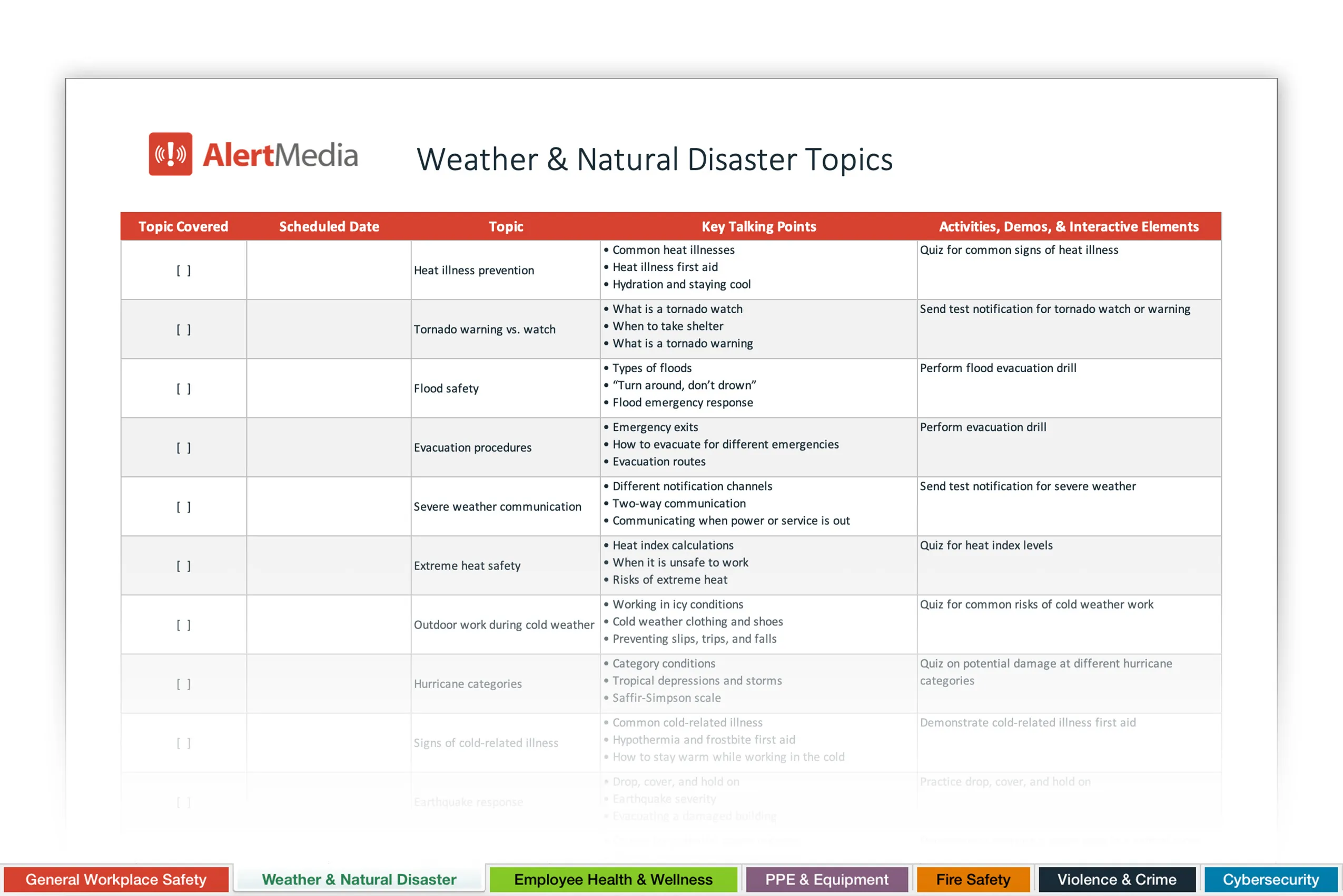 Preview of a spreadsheet full of safety meeting topics with talking points
Preview of a spreadsheet full of safety meeting topics with talking points
Putting Your Powerful Safety Message to Work
A consistent feedback loop of training, education, and practice is an essential component of a strong safety culture and emergency preparedness. Frequent safety moments are a great way to complement more extensive and rigorous training programs, as they allow you to reinforce concepts on a more frequent basis.
In industrial settings, safety moments can set the tone for the day. Whether you’re reviewing a common topic or describing a new risk, an engaging discussion can get workers focused on keeping themselves and their peers safe. Five minutes every morning to ensure everyone goes home healthy and happy is time well spent.


